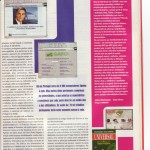A verdadeira razão pela qual todos os Bancos Centrais farão sempre o possível e o impossível para que nenhum banco ou país vá à falência é um tabu absoluto que ninguém ousa quebrar.
O silêncio sobre o grande segredo tem razão de ser: uma vez descoberto, seria capaz de provocar o pânico generalizado.
Francisco Louçã, notável economista de esquerda, têm-se insurgido nos últimos tempos contra a família Espírito Santo – escreveu até um livro – que diz ser “a casta que tem governado Portugal“.
À primeira vista admirei-me com a indignação de Louça, ainda mais sendo um reputado economista de esquerda! Mas depois resignei-me.
Louça está também ele a ajudar a perpetuar a grande ilusão. A ajudar a esconder o grande tabu. A questão é, será propositadamente ou por desconhecimento?
Ao indignar-se e vir para os jornais denunciar as promiscuas ligações entre a política e a banca, neste caso entre o BES e todos os governos anteriores, Louça e os seus acólitos, pretendem demonstrar que o sistema está bem, funciona e recomenda-se, estes é que foram casos de excepção e que, como tal, deverão ser corrigidos pela justiça.
Tornando desta forma o caso num caso de polícia, evita que se cheque à verdadeira questão; e a verdadeira questão, é um grande tabu!
E o tabu é este: O dinheiro que usamos, que recebemos de ordenado e com o qual pagamos o almoço, é FALSO. Parece inconcebível? Pois parece, mas é mesmo assim!
Até há 50 anos (Nixon Shock) atrás o dinheiro valia o seu valor em ouro e era controlado pelos bancos. Quando os políticos perceberam que só ganhavam eleições se atirassem dinheiro para cima das pessoas e começaram a ter cada vez menos para o fazer, tiveram uma brilhante ideia: “mas espera lá, se nós é que mandamos, porque não imprimir notas iguais às outras e decretar que são tão válidas como as outras?”
A partir daí, as máquinas de impressão não mais têm parado. Em períodos pré-eleitorais, trabalham até 24h sem parar.
Acontece que por vezes, aparecem chico-espertos – e o tuga é pródigo nesta matéria – que percebem a marosca e resolvem entrar no esquema.
A lógica é mais ou menos esta: “Espera lá, se isto é tudo falso, deixa-me imprimir também umas notas. Se der para o torto, estou sempre em casa, porque os tipos farão tudo para que não se descubra que é tudo uma grande fraude. E a melhor maneira de fazer isto como deve ser é ter como sócios alguns dos mafiosos que controlam o esquema, ou seja os políticos.”
Arranja-se uma impressora (para conseguir uma impressora basta abrir um banco) e vá de imprimir notas para o próprio bolso. (os bancos imprimem dinheiro sob a forma de crédito)
E tudo funciona na perfeição, desde que não se abuse. O que Ricardo Salgado fez foi esticar a corda. Esticou tanto que partiu.
E o melhor e mais incrível de toda esta história é que o verdadeiro dinheiro ainda existe! Não se pode imprimir como o outro e ninguém lhe põe a vista em cima, excepto os bancos. Só os bancos são autorizados a ter dinheiro verdadeiro, do antigo, que emprestam e compram entre eles. Parece inconcebível outra vez? Pois parece, mas é mesmo assim!
As moedas foram criadas para facilitar as transacções comercias e valiam efectivamente o seu peso em ouro. As notas foram criadas para evitar carregar grandes pesos em moedas e significavam uma garantia, dada pelo banco emissor, em como o valor nelas inscrito estava guardado algures no banco sob a forma de barras de ouro, constituindo desse modo uma garantia e podendo a nota ser trocada pelo ouro a qualquer altura.
As garantias de hoje em dia, são a palavra dos políticos, e o seu valor passou a ser o que os políticos entendessem.
Lembram-se do jogo do monopólio em que, quando já havia poucas notas, alterava-se o valor de cada nota ou criávamos notas a partir de folhas de papel e concordávamos entre todos que eram válidas? Pois, é exactamente igual
O dinheiro de hoje é controlado secretamente pelos governos com um único objectivo: Eleger políticos ao tornar possível o crescimento eterno.
Ainda mais grave: é a própria democracia que está em jogo no momento em que se pare de imprimir dinheiro para dar às pessoas de modo a que possam consumir sempre cada vez mais.
Percebe-se portanto, que até Louça ajude a perpetuar a grande ilusão. Até quando?
Adenda: Austeridade? Não liguem, há que castigar o menino mal comportado para passar a ser bom aluno e não voltar a fazer o mesmo.






